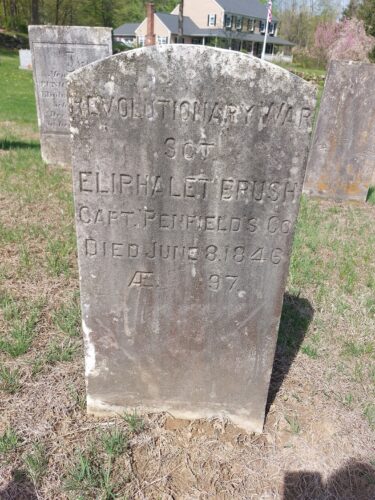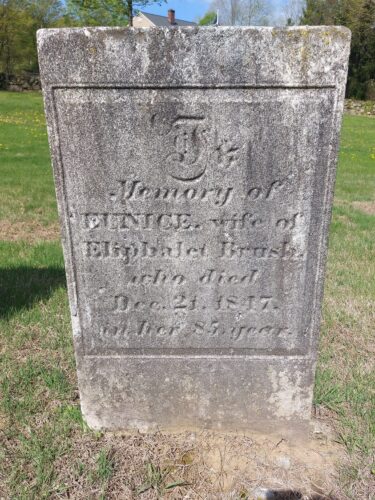By Susan Kweskin
It’s 1792 in Ridgefield, where a wedding will soon take place. The soon-to-be bride is
Eunice Chapman Hull, born in Fairfield in the spring of 1763. Eunice will take the hand
of the twice-married Eliphalet Brush in less than three weeks… unless someone in the
community objects to their union.
Eliphalet, born in 1749 in Ridgefield, is a desirable man. His 12 children (by the time he
stops acquiring and begetting offspring) attest to his virility. His service as a sergeant in
the Continental Army speaks to his patriotism and bravery. His role as Ridgefield’s
Assistant Assessor reflects the efficiency and economy with which he runs his
Ridgebury farm. In this official capacity, he assesses the value of his neighbors’ homes
and outbuildings, their lands, and their belongings — including their slaves. He will one
day serve Ridgefield as representative to the Connecticut state legislature.
Eliphalet’s first two wives have perished. His first bride, Hannah Hamilton, whom he wed
in 1773, died a year later at the tender age of 20. He married again in 1777 to Abigail
Dunning, who died in 1791. A year after Abigail’s passing, Eliphalet is again ready to
stand at the altar with Eunice – the widow of Seth Lee who has two children.
Where did the couple meet? And how did Eliphalet court her?
Courtship rituals in the New England of the mid-1700s weren’t what they are today.
Young couples considering marriage might “bundle” or “tarry.” (What? Walk all that
snowy way home at this hour of the night?!) Reverend Andrew Burnaby, a visitor from
England who spent a few months in New England described the practice this way:
“A very extraordinary method of courtship, which is sometimes practised amongst the
lower people of this province, and is called Tarrying, has given occasion to this
reflection. When a man is enamoured of a young woman, and wishes to marry her, he
proposes the affair to her parents, (without whose consent no marriage in this colony
can take place); if they have no objection, they allow him to tarry with her one night, in
order to make his court to her.”
At their usual time the old couple retire to bed, leaving the young ones to settle matters
as they can; who, after having sate up as long as they think proper, get into bed
together also, but without pulling off their undergarments, in order to prevent scandal. If
the parties agree, it is all very well; the banns are published, and they are married
without delay. If not, they part, and possibly never see each other again; unless, which is an accident that seldom happens, the forsaken fair-one prove pregnant, and then the
man is obliged to marry her, under pain of excommunication.”
The marriage banns Reverend Burnaby mentions are meant to ensure the orderly
celebration of marriage –- and to suss out and prevent “incestuous and other unlawful
marriages.” Betrothed couples are required to broadcast to the community their
intention to marry “in some public meeting or congregation on the Lord’s day, or on
some public fast, thanksgiving, or lecture-day, in the town, parish, or society where the
parties, or either of them do ordinarily reside” at least eight days before the ceremony
was to occur.
The twice widowed Eliphalet and Eunice probably won’t spend a night bundled up
together, but they must post their banns three times before they will be allowed to stand
before a justice of the peace. (Weddings don’t take place in churches.)
How are incestuous unions defined? The details are very specific. Note, though, that
cousins seem to be fair game.
Woe unto those who violate these rules! An unlawfully wedded couple face automatic
disinheritance of any child born to them, mandatory and prominent displaying of an
emblem on their clothing of a capital “I” for incest, even public whipping.
The rules for how the capital “I” is to be worn are clearly spelled out:
No one, apparently, has any objection to the marriage of Eunice and Eliphalet. They are
united in 1792. Was it love that led this couple to the altar? In 18 th century Connecticut,
love was not a primary consideration. Marriage was fundamental, the bedrock institution
on which social, economic, family, moral, and religious stability hinged. Adults were
expected to marry and (if necessary) remarry. Practicality and the need for a working
partnership might trump matters of the heart.
Did Eunice (or any other bride of her day) give thought to her legal rights when she
married? Married women did not then exist legally: husbands had complete legal
authority. A woman’s identity at birth came from her father; identity after marriage
became that of her husband. Everything a married woman owned became her
husband’s, including the clothes on her back. She could not own or work in a business,
and any wages she might have earned through her labor could be claimed by her
husband. There could be no contracts in her name. She had no rights to her children: if
she separated or divorced, she would have to leave her children behind. Husbands had
a legal right to sexual access – within a marriage, sexual consent was implied.
In contrast, unmarried women were legally entitled to live where they wanted and to
support themselves as long as their occupation did not require a license or college
degree. A single woman could sign contracts, own real estate, and acquire her own
personal effects.
Whatever misgivings Eunice might (or might not) have had, her union with Eliphalet
proved long and fruitful, and she bore eight children, including a daughter also named
Eunice. She lived to see 1847 — a year after her husband passed at age 97. She and
Eliphalet lie near one another in Ridgebury cemetery.


*Ben Franklin had this to say about marriage: “Keep your eyes wide open before
marriage and half shut afterward.”
For more details about old-time marriage in New England, click here.




